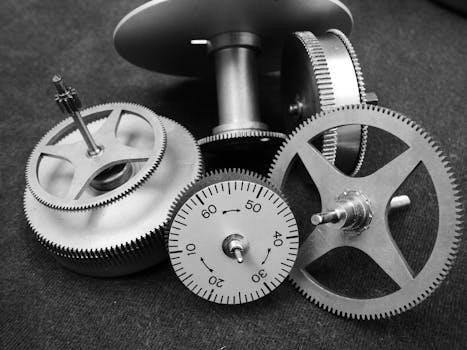polk dsb1 soundbar manual
Category : Manuals
The Polk DSB1 Soundbar is a 2.1 channel system designed for immersive home theater experiences. It features a wireless subwoofer, Bluetooth connectivity, and wall-mounting capability, ensuring enhanced audio quality and convenience.
1.1 Overview of the Polk DSB1 Soundbar System
The Polk DSB1 Soundbar System is a 2.1 channel home theater solution, combining a sleek soundbar with a wireless subwoofer for enhanced bass performance. Designed for simplicity and immersive audio, it supports Bluetooth connectivity for wireless streaming from devices. The system is wall-mount-ready, featuring keyhole slots for easy installation. It operates on a 2.4GHz frequency, ensuring reliable wireless connections between components. The soundbar is compatible with various audio sources, including TVs, smartphones, and tablets. Its compact design makes it suitable for small to medium-sized rooms, delivering clear dialogue and dynamic sound. The Polk DSB1 is an ideal choice for users seeking a balanced blend of performance, convenience, and affordability.
1.2 Key Features of the Polk DSB1 Soundbar
The Polk DSB1 Soundbar boasts a range of features that enhance home audio experiences. It includes a built-in Bluetooth module for seamless wireless connectivity, allowing users to stream audio from smartphones, tablets, and other devices. The system comes with a wireless subwoofer, delivering deep bass without the clutter of cables. Additionally, the soundbar supports wall mounting, thanks to its built-in keyhole slots, making it easy to integrate into any room’s decor. The remote control offers convenient operation, with buttons for adjusting volume, switching sources, and programming the soundbar to respond to other remotes. These features make the Polk DSB1 a versatile and user-friendly option for improving TV audio and enjoying music wirelessly.
Setting Up the Polk DSB1 Soundbar
Setting up the Polk DSB1 Soundbar involves unboxing, connecting the wireless subwoofer, pairing surround speakers, and activating Bluetooth pairing mode for a seamless audio experience.
2.1 Unboxing and Initial Setup
Unboxing the Polk DSB1 Soundbar reveals the soundbar, wireless subwoofer, remote control, and necessary cables. Begin by placing the soundbar in your desired location and connecting it to a power source. Next, unpack the wireless subwoofer and position it in the room for optimal bass performance. Ensure both the soundbar and subwoofer are turned on. Use the remote control to navigate through the initial setup menu, selecting your preferred audio settings and pairing options. For wireless connectivity, press and hold the Sync button on the soundbar for 3 seconds to pair the subwoofer. This process ensures a seamless audio experience right out of the box.
2.2 Connecting the Wireless Subwoofer
To connect the wireless subwoofer to the Polk DSB1 Soundbar, ensure both devices are powered on. Locate the Sync button on the back of the soundbar and press and hold it for 3 seconds. This activates the pairing mode. The subwoofer will automatically connect to the soundbar within a few seconds. If the connection fails, unplug the subwoofer, wait 10 seconds, and plug it back in. Repeat the syncing process. Ensure the subwoofer is placed on the same floor as the soundbar for optimal performance. Once connected, you’ll enjoy enhanced bass and a immersive audio experience. If issues persist, refer to the troubleshooting section for further guidance.
2.3 Pairing Surround Speakers
To pair surround speakers with the Polk DSB1 Soundbar, start by ensuring the soundbar is in pairing mode. Press and hold the Source button for 3 seconds until the LED indicator flashes. Next, aim your TV remote at the soundbar and press the Volume Up button. This syncs the remote with the soundbar. Once connected, the surround speakers will automatically pair with the system. For optimal performance, place the speakers at ear level and equidistant from the listening area. If pairing fails, reset the soundbar and repeat the process. Ensure no obstacles block the line of sight between the remote and soundbar for reliable connectivity. Proper pairing ensures a seamless surround sound experience.
2.4 Bluetooth Pairing Mode Activation
To activate Bluetooth pairing mode on the Polk DSB1 Soundbar, press and hold the Bluetooth button on the remote control until the LED indicator flashes blue. Alternatively, you can enable pairing mode by saying, “Alexa, pair my TV,” if your system supports voice commands. Once in pairing mode, go to your device’s Bluetooth settings and select “Polk DSB1 Soundbar” from the available options. The soundbar will confirm the connection with a steady blue light. If pairing fails, reset the soundbar by unplugging it, waiting 10 seconds, and plugging it back in. Ensure no other devices are interfering with the 2.4GHz frequency band for a stable connection. This feature allows wireless streaming of your favorite audio seamlessly.

Operating the Polk DSB1 Soundbar
Operate the Polk DSB1 Soundbar using the remote control to adjust volume, switch sources, and access Bluetooth connectivity. Enjoy immersive audio with ease and convenience.
3.1 Using the Remote Control
The Polk DSB1 Soundbar comes with a remote control that simplifies operation. Key functions include adjusting volume, muting, and selecting audio sources. Press and hold the Source button to switch between inputs. Use the Sync button to pair the subwoofer. For Bluetooth, activate pairing mode via the remote. To program the remote for other devices, press and hold the Source button, then use the Volume Up button while aiming your TV remote at the soundbar. Ensure batteries are installed correctly and replace them when necessary. Keep the remote within line of sight for optimal performance. Regularly check for firmware updates to enhance functionality.
3.2 Adjusting Sound Settings
The Polk DSB1 Soundbar offers customizable sound settings to enhance your listening experience. Use the remote to adjust bass, treble, and balance for optimal audio. Press the EQ button to cycle through preset modes like Movie, Music, or Night Mode. Night Mode reduces dynamic range, making dialogue clearer at lower volumes. For personalized sound, adjust settings via the remote or connected device. Ensure the subwoofer level is balanced for immersive bass. Experiment with settings to find your preferred audio profile. These adjustments ensure a tailored sound experience, whether watching movies, listening to music, or streaming content. Regularly review settings to optimize performance for different content types.
3.3 Switching Between Audio Sources
To switch between audio sources on the Polk DSB1 Soundbar, press the Source button on the remote control or the soundbar itself. This cycles through available inputs like HDMI, optical, and Bluetooth. Use the remote’s navigation buttons to select the desired source. Ensure your devices are properly connected to the correct ports. For Bluetooth, put the soundbar in pairing mode and connect from your device’s settings. The soundbar will automatically switch to the active input. If no audio is detected, check connections and ensure the source device is powered on. This feature allows seamless transitions between different audio sources, enhancing your entertainment experience with minimal effort.
Customizing the Polk DSB1 Soundbar
Customize your Polk DSB1 Soundbar by programming the remote to control other devices and wall-mounting for a sleek setup. Built-in keyhole slots simplify installation, ensuring optimal placement and sound quality.
4.1 Programming the Remote Control
Programming the Polk DSB1 Soundbar remote allows seamless control of other devices. Press and hold the Source button for 3 seconds, then press Volume Up. Aim your TV remote at the soundbar and press desired buttons to sync. This feature enables one-touch control for power, volume, and input selection. Ensure the soundbar is in pairing mode before starting. Once programmed, test functionality with various commands to confirm compatibility. This customization enhances convenience, reducing clutter from multiple remotes. Follow the manual for specific device codes if needed. Proper synchronization ensures smooth operation across all connected devices.
4.2 Wall Mounting the Soundbar
The Polk DSB1 Soundbar is designed with built-in keyhole slots for easy wall mounting, enhancing space efficiency and aesthetic appeal. To mount, locate wall studs and drill pilot holes. Attach the provided mounting brackets to the soundbar and align with the wall anchors. Ensure the soundbar is level using a spirit level tool. Secure the soundbar firmly to the wall, tightening screws gently to avoid damage. For optimal audio performance, position the soundbar at ear level and centered with your TV. Refer to the manual for specific bracket dimensions and installation guidelines. Proper mounting ensures stability and maintains the soundbar’s sleek appearance while delivering high-quality sound.

Troubleshooting the Polk DSB1 Soundbar
Common issues include RF interference, sync problems with the subwoofer, and connectivity glitches. Resetting the soundbar to factory settings often resolves these issues effectively and quickly.

5.1 Resetting the Soundbar to Factory Settings
Resetting the Polk DSB1 Soundbar to factory settings can resolve various issues. To do this, unplug the subwoofer, turn on the soundbar, and play audio. Press and hold the Source button for 3 seconds, then press Volume Up on the remote. Alternatively, press and hold the Sync button on the back for 3 seconds. The soundbar will reset and restart. This process restores default settings, fixing connectivity or sync problems. Note that all custom settings will be lost, requiring you to set up the soundbar again. This method is effective for addressing persistent issues without advanced troubleshooting.
5.2 Resolving Sync Issues with Subwoofer

To resolve sync issues with the Polk DSB1 subwoofer, first ensure both the soundbar and subwoofer are powered on. Unplug the subwoofer, wait 10 seconds, and plug it back in. Press and hold the Sync button on the soundbar’s back for 3 seconds until the LED flashes. This re-pairs the subwoofer. If issues persist, reset the soundbar to factory settings. Additionally, check for RF interference from devices using the 2.4GHz band, as this can disrupt connectivity. Move wireless devices away or switch them to a different frequency band. Ensure the subwoofer is within range and unobstructed. If problems continue, consult the user manual or contact Polk support for further assistance.
5.3 Addressing RF Interference Problems
RF interference can disrupt the Polk DSB1 Soundbar’s performance, especially from devices operating in the 2.4GHz band, such as Wi-Fi routers or cordless phones. To address this, move wireless devices away from the soundbar or switch them to a different frequency band. Ensure the soundbar and subwoofer are at least 3 feet apart and not obstructed by walls or furniture. If interference persists, reset the soundbar to factory settings and re-pair the subwoofer. Additionally, consider using a wired connection for the subwoofer if possible. For severe issues, consult the user manual or contact Polk support for further troubleshooting steps.
Maintenance and Care
Regularly clean the Polk DSB1 Soundbar with a soft cloth to remove dust. Avoid harsh chemicals and ensure all vents are clear for optimal performance and longevity.
6.1 Cleaning the Soundbar
To maintain the Polk DSB1 Soundbar’s performance and appearance, clean it regularly with a soft, dry cloth. Avoid using harsh chemicals or abrasive materials, as they may damage the finish. Gently wipe down the exterior, paying attention to vents and grilles to ensure proper airflow. For stubborn stains, lightly dampen the cloth with water, but avoid moisture entering the ports or openings. Regular cleaning prevents dust buildup, which can affect sound quality. Never use aerosol cleaners or polish, as they may leave residues. For the remote control, use a slightly dampened cloth to remove fingerprints and smudges. Proper maintenance ensures optimal functionality and longevity of your soundbar system.
6.2 Updating Firmware

To ensure optimal performance, regularly update the Polk DSB1 Soundbar’s firmware. Visit the Polk Audio website to check for the latest firmware version. Download the update file to a USB drive, then connect it to the soundbar’s USB port. Turn on the soundbar and follow the on-screen instructions to begin the update process. Do not interrupt the update, as it may cause system instability. Once completed, the soundbar will automatically restart. Firmware updates improve functionality, fix bugs, and enhance compatibility with connected devices. Always use the official Polk Audio website to download updates to avoid security risks. Updating firmware ensures your soundbar operates at its best, delivering superior audio quality and reliability.

Additional Features
The Polk DSB1 Soundbar offers built-in Bluetooth connectivity for wireless audio streaming and wall-mounting capability for seamless integration into any home theater setup, enhancing convenience and performance.

7.1 Built-in Bluetooth Connectivity
The Polk DSB1 Soundbar features built-in Bluetooth connectivity, enabling seamless wireless audio streaming from compatible devices. This feature allows users to pair smartphones, tablets, or laptops effortlessly, ensuring high-quality sound reproduction. To activate Bluetooth pairing mode, press the Bluetooth button on the remote control or use voice commands if integrated with smart devices. Once paired, the soundbar automatically connects to the last paired device, providing a convenient and uninterrupted listening experience. This wireless capability enhances the soundbar’s versatility, making it ideal for streaming music, podcasts, or movies directly from your preferred devices without the need for cumbersome cables.

7.2 Surround Sound Technology
The Polk DSB1 Soundbar incorporates advanced surround sound technology to deliver an immersive audio experience. By utilizing wireless rear speakers and a subwoofer, it creates a 360-degree soundstage, enhancing movie and music playback. The system optimizes audio processing to ensure clear dialogue and dynamic sound effects, providing a cinematic feel in any room. This technology works seamlessly with Bluetooth connectivity, allowing users to enjoy high-quality wireless audio from various devices. The surround sound feature is easy to set up and enhances the overall listening experience, making it ideal for home theaters and entertainment systems. It ensures that every detail in the audio is crisp and lifelike, offering unparalleled sound quality for its class.

User Manual and Resources
The Polk DSB1 Soundbar manual is available online, providing detailed setup guides, troubleshooting tips, and technical specifications. It also includes FCC ID information for compliance assurance.
8.1 Accessing the Polk DSB1 Soundbar Manual
To access the Polk DSB1 Soundbar manual, visit the official Polk Audio website or search online for the specific model. The manual is available in PDF format, covering setup, troubleshooting, and technical specifications. It includes detailed instructions for connecting wireless subwoofers, pairing surround speakers, and activating Bluetooth. Additionally, the manual provides information on resetting the soundbar to factory settings and addressing RF interference issues. For convenience, the manual is also available through platforms like ManualsLib or by searching for “Polk DSB1 Sound Bar manual.” Ensure to download the correct version for your model to access accurate and relevant information.
8.2 Online Support and FAQs
For additional assistance, Polk Audio offers comprehensive online support and FAQs on their official website. These resources provide detailed troubleshooting guides, setup instructions, and answers to common questions about the DSB1 Soundbar. Users can find solutions for issues like syncing the wireless subwoofer, resolving RF interference, and activating Bluetooth pairing mode. The FAQs also cover topics such as resetting the soundbar to factory settings and programming the remote control. Additionally, Polk Audio’s support page includes downloadable manuals, firmware updates, and video tutorials. Visitors can search by model or browse through categories to find relevant information quickly. This online support ensures users can easily resolve issues and optimize their soundbar experience without needing to contact customer service directly.
Conclusion
The Polk DSB1 Soundbar is a versatile and high-performance audio system designed to enhance home entertainment experiences. With its wireless subwoofer, Bluetooth connectivity, and surround sound capabilities, it delivers immersive audio quality. The system is easy to set up and customize, offering features like wall mounting and remote control programming. Regular maintenance, such as cleaning and firmware updates, ensures optimal performance. The comprehensive manual and online support provide users with detailed guidance and troubleshooting solutions. Whether for movies, music, or gaming, the Polk DSB1 Soundbar is a reliable choice for upgrading your audio setup. Its blend of functionality and quality makes it a standout option for home theater enthusiasts.






































































